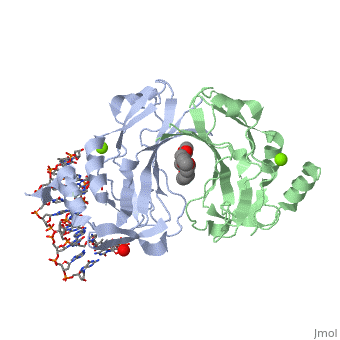TBX5
From Proteopedia
| |||||||
| TBX5 dimer complex with DNA, PEG and Mg+2 ion, 2x6v | |||||||
|---|---|---|---|---|---|---|---|
| Ligands: | , | ||||||
| Related: | 2x6u | ||||||
| |||||||
| Resources: | FirstGlance, OCA, RCSB, PDBsum | ||||||
| Coordinates: | save as pdb, mmCIF, xml | ||||||
Contents |
Introduction
TBX5 is a protein of which mutants can cause the Holt-Oram syndrome. It has been crystallised twice, one with and one without the corresponding DNA. It is different from the TBX3 and Brachyury structures in the way that it dimerises, and that it has been bound to a half-site rather than a full palindromic site. The difference in dimerisations calls into question whether these proteins dimerise naturally or, as their in vivo predicted binding sites suggest, bind monomerically to the DNA. These proteins generally do not dimerise in conserved regions.
A bioinformatic search suggests that two nuclear localisation signals exist, one in the T-box domain and one in the transactivation domain. See also Transcription and RNA Processing.
Crystal structure
Lone TBX5 crystallised in the P212121 space group to 1.9 Å resolution (2x6u), whereas that with the half-site DNA crystallised to 2.2 Å resolution in the P6122 space group (2x6v). TBX5 has a very similar structure to those solved structures of TBX3 and Brachyury, and superimposing TBX3 and TBX5 give a root mean standard deviation of 2.1 Å over 174 atoms. These structures will be discussed in turn.
TBX5 bound to DNA (2x6v)
The DNA for this crystal structure was taken from the ANF promoter, a known binding site for T-box proteins. Although there is only room for one TBX5 monomer to bind to a half-site, two TBX5 monomers were seen in the asymmetric unit, with the other interacting with the DNA-bound form in the asymmetric unit through two contact regions. A β sheet conntects these through strand G and G' (of each monomer), involving eight amino acids. This is additionally stabilised by a disulphide bridge from Cys202 of both proteins: this residue is not conserved which may explain why TBX3 and Brachyury do not adopt this dimerisation state. Analytical centrifugation suggests that TBX5 is a monomer when in solution and bound to DNA, and the observed dimerisation is simply an artifact of crystallising the protein. The second, more minor contact site involves a loop region which is predicted to be disordered by the RONN algorithm in the monomeric state, and extends from residues K126-P132 (sequence KAEPAMP).
The TBX5 310 helix at the C-temrinus takes part in recognising DNA. Helix 3, like in Brachyury, interacts strongly with DNA. Residues F232 and F236 are positioned for direct interactions with the minor groove.
Lone TBX5 (2x6u)
Lone TBX5 crystallised with just one TBX5 in the asymmetric unit, failing to form the disulphide bridge as seen in the first crystal structure. However, the region which formed the minor contacts with the other TBX5 in the DNA-bound crystal structure is disordered in this structure, as predicted by the RONN algorithm. Similar disordered predictions are seen in Brachyury, although in the DNA-bound state this has a well-defined electron density (this could be stabilised by the crystal packing, however) and is part of a long loop region. The 310C helix is also disordered in the apo-form of TBX5.
3D structures of TBX5
Additional Resources
For additional information, see: Transcription and RNA Processing
Proteopedia Page Contributors and Editors (what is this?)
Michal Harel, David Canner, Helen Ginn, Alexander Berchansky

